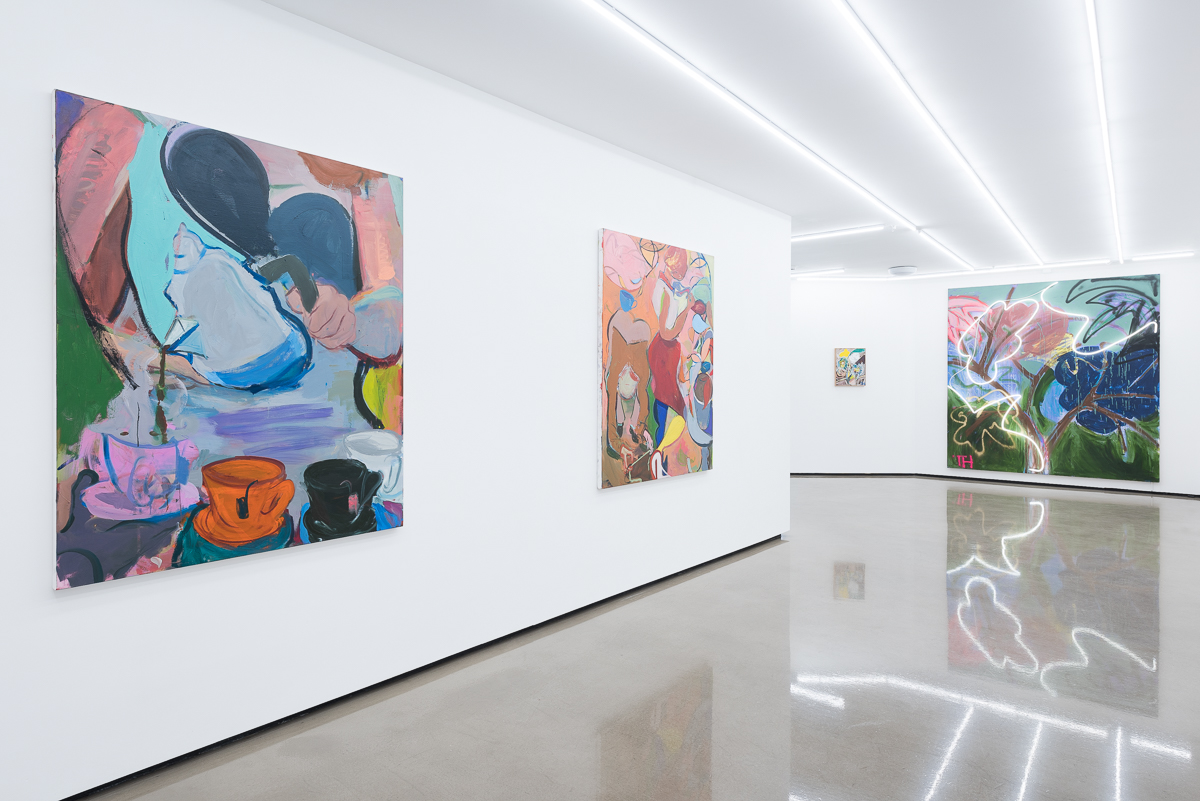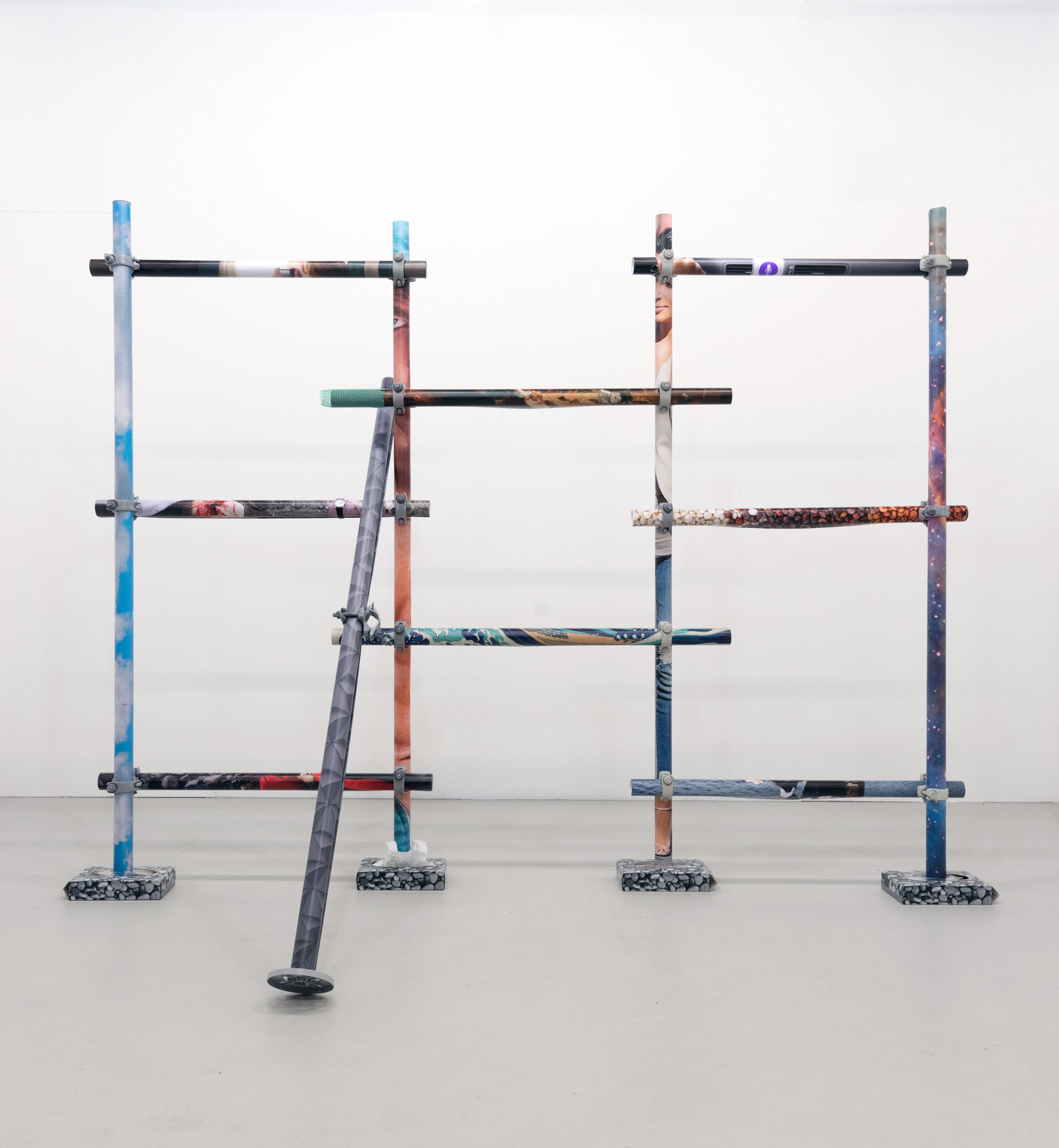Scarlett Bowman

"I've always had a playful approach to making work, where colour and intuitiveness take precedence..."
Could you tell us a bit about yourself. How long have you been a practicing artist and where did you study?
Sure - I had a bit of an unusual journey into the art world. Even though I majored in Fine Art, Textiles, Photography and History of Art at school, we weren't really encouraged to study Fine Art at BA level so I ended up studying Classics at Newcastle University for 3 years before embarking on a Foundation in Art and Design at City & Guilds and then my Masters at Chelsea College of Art.
It was the only place I applied and at the time didn't place too much emphasis on it. I feel like I have done a lot of studying and would love to do a PHD but I think there comes a point when at post-graduate level its less teaching and more self-directed, which I can do at the studio with fellow artists. I have essentially always been making work but in terms of actually practicing i’d say 5 years.
Domestic bliss (yellow, blue, green, pink), 2016
Mixed Recycling (blue), 2016
Mixed Recycling (yellow), 2016
You often use materials like: plastics, latex, composites and textiles. Could you tell us the thoughts behind this?
Incorporating a wide range of materials has always been part of my process. I can trace this back to the very beginning really, I didn't have much spare cash to be buying expensive art-related materials and so I made work with stuff I found all over the place - from literally around the house to skips, to discarded builders materials on the streets etc. As a kid I used to collage old magazine scraps and I returned to this hobby when I left University, just in my spare time. This 'collage' based approach developed to collaging found items and cheap materials purchased from local hardware and pound shops and as a result, this has naturally developed into a distinctly utilitarian-based aesthetic. This then got me thinking about this idea of dependency and how far fabrics have developed over the years as we move towards a world of total fabrication. That being said I've always had a playful approach to making work, where colour and intuitiveness take precedence and Iv actually started exploring collage in its pure form with pattern and block colour and seeing where this leads. It's a constant development that naturally takes its course.
Could you tell us about the series of works titled “Fragments” and “Soft Work”?
The fragments developed out of the soft work series. Essentially my approach and to an extent the process applied to both is very similar - i'll acquire the materials then start arranging and combining them together. I like the solidarity and almost 'final-ness' of the fragments and then the contrasting softness of the tapestries. Geography and space also has a direct impact on the work, my studio is pretty small which presents obstacles in itself. The soft work can be easily folded up and the fragments are small enough to be stored.
The fragments are made of composite which enables me to cast a wide variety of objects and materials. Sort of like painting but with readymades. I like this idea of archiving objects and fabrics, almost frozen in time. The process is always done blindly - as in they are worked on back-to-front so I never know the results until the composite has cured and I flip them upside down. Its addictive.
The soft work is similar in the sense that the materials are playfully re-arranged into a composition that begin to take a form of its own.
Clean as a Whistle, 2016
Cloud 9, 2016
What do you hope the viewer gains/reacts from looking at your work?
I don't often think too much about the viewer's response if i'm honest, I guess essentially there is a large sense of familiarity embedded within the work from the objects and materials used which is always an initial reference point when discussing my work with someone seeing it for the first time. The special thing for me about looking at art in general is that it's a depiction of the specific time and life in which it was made. In a sense this is why I always come back to this idea of collage and assemblage as for me it acts as a metaphor for recording information...
How do you go about naming your work?
It's the only thing I don't enjoy, giving them titles and I find everyone’s got differing opinions on the importance of this. I feel like it's categorising the work or putting it in a box. Recent work has been named after the descriptive language on the packaging the materials come in such as 'clean as a whistle', 'gently does it, 'time to shine' etc. I think there's something playful in using these gimmicks that someone else has come up with. It ties back in to the work itself.
Powering Through, 2016
untitled fragment (blue,orange), 2016
What artwork have you seen recently that has resonated with you?
Making and Unmaking at the Camden Arts Centre curated by Duro Olowu was definitely inspiring and one to remember. Having such a strong craft based approach to making work this was an eclectic mix of work from West-African textiles, to photographs, sculpture, ceramics, painting and more. In particular the tapestries of Anni Albers and the Erik Mack installation. Yesterday I went to see the new Abstract Expressionist exhibition at the Royal Academy, and thought it was superb. There is nothing like seeing these giant paintings in the flesh towering over you. The colour, the brush marks and the super playful and intuitive nature of them was inspiring. Not being a painter myself but seeing their use of collage was interesting, particularly the work of Conrad Marca-Ralli and the colourful early works of Franz Kline. I've always been inspired by the process of collage and its results, and have recently been looking at a wide range of approaches to this. In particular the Dutch African wax prints and the moroccan rugs made in the Atlas Mountains and how through traditional craft practices, they juxtapose various symbols, colours and iconography.
Tell us a bit about how you spend your day/studio routine? What is your studio like?
Funnily enough I'm literally moving studios this week, iv moved three times in the past two years but all on the same corridor. I work in a very old building called The Old Laboratories which was build to house the vast gas chambers back in the early 1900's. Its a special place and iv grown very attached to it. Sadly they are being demolished in March next year to make way for some large expensive nasty flats! Gentrification at its finest...
It’s a pretty normal 9-5 routine, there’s a delicious cafe on site that serves up lunch and as much tea and coffee you could ask for. There's a mix of artists and designers on site so your never far from the smell of paint.
I have been in a relatively small studio for the past couple years and now moving to a much larger space. The space has a direct impact on the work being produced as your always limited to your confines. That’s partly how the soft work came about - I needed to find a way of working that could allow for easy storage!
POLYMER (installation shot), (Valérie Kolakis, Scarlett Bowman, Neal Rock), Fold Gallery, 2016
What does the future hold for you as an artist? Is there anything new and exciting in the pipeline you would like to tell us about?
Im currently preparing some work to be exhibited at the monumental St Cyprian's Church in Marylebone as part of my involvement with the project 'Melt' with MTArt and a host of other talented artists and collaborators.
Then in February next year I head to Senegal, Dakar for a residency at the cultural centre - Thread, hosted by the Josef and Anni Albers Foundation which I am very much looking forward. It takes place 7 hours from central Dakar in a small rural village called Sinthian and will be my first residency. The fact there is a language barrier coupled with no wifi and no distractions will be an extreme contrast to London and I am excited to produce some new work there and see where that leads.
Interview published: 30/09/16





